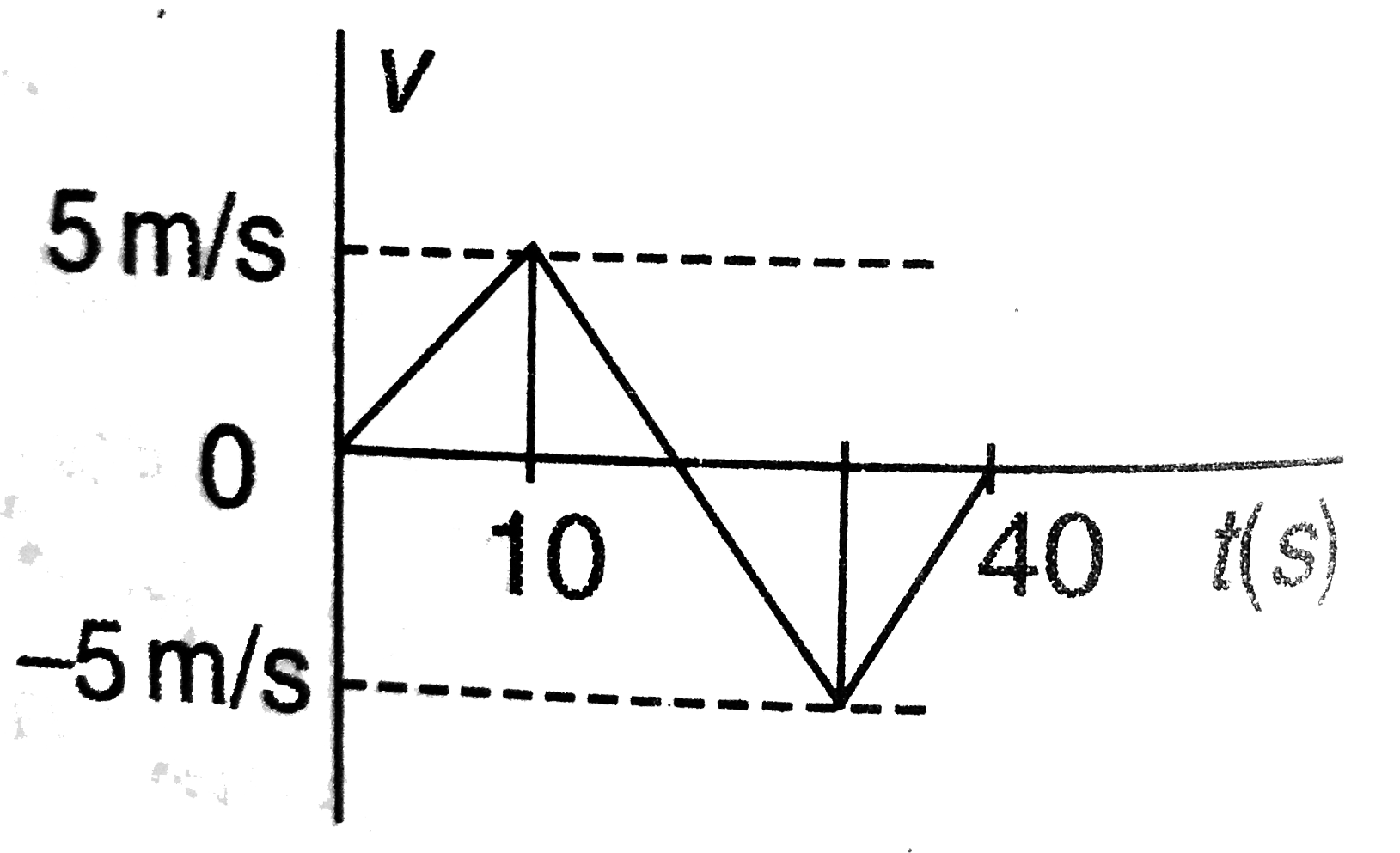From the velocity time plot shown in figure find the distance travelled by the particle dureing the first 40 seconds. Also find the average velocity during this period.
 Solution in Tamil
Solution in Tamil
Distance in first 40 sec = /_\sec = /_\OAB+/_\BCD
= 1/2xx5xx20+ 1/2 xx5xx20
= 50+50
=100 m

Average velocity is 0 as the displacement is zero.
Topper's Solved these Questions
- REST AND MOTION : KINEMATICSBook:HC VERMAChapter:REST AND MOTION : KINEMATICSExercise:Objective -2
Explore 10 Videos
- PHYSICS AND MATHEMATICSBook:HC VERMAChapter:PHYSICS AND MATHEMATICSExercise:Exercises
Explore 34 Videos
- ROTATIONAL MECHANICSBook:HC VERMAChapter:ROTATIONAL MECHANICSExercise:Exercises
Explore 86 Videos
Similar Questions
Consider the motion of the tip of the minute hand of a clock. In one hour
View SolutionA vector →A makes an angle of 20∘and→B makes an angle of 110∘ with the X-axis. The magnitude of these vectors are 3 m and 4 m respectively.Find the resultant
View SolutionA wheel is making revolutions about its axis with uniform angular acceleration. Starting from rest, till it reaches 100 rev/sec in 4 seconds. Find the angular acceleration.
View SolutionFigure shows x-t graph of a particle. Find the Time T Such that the Average Velocity of the Particle During the Period 0 to T is Zero..

View SolutionA particle starting from rest moves with constant acceleration. If it takes 5.0 s to reash the speed 18.0 km/h find a. the average velocity during this period, and b. the distance travelled by the particle during this period.
View SolutionFrom the velocity-time plot shown in Fig. find the distance travelled by the particle during the first 40s. Also find the average velocity during this period.

View SolutionThe velocity-time plot is shown in figure. Find the average speed in time interval t=0 to t=40s during the period.

View SolutionA point moves rectilinearly in on direction. Figure shows the distance s traversed by the point as a function of the time t. Using the plot find: (a) the average velocity of the point during the time of motion, (b) the maximum velocity, (c) the time moment t_0 at which the instantaneous velocity is equal to the mean velocity averaged over the first t_0 seconds.
View Solutionthe velocity of a particle varies with time as shown below the distance travelled by the travelled by the particle during t=2s"and" t= 6s. Is
View SolutionFigure-1.20 shows displacement-time graphof a particle. Find the time during motion such that the average velocity of the particle during that period is zero.

View SolutionA particle moves in a straight line from origin. Its velocity time curve is shown. Find the distance of particle at the =8sec. From the origin and the distance travelled by the particle during first 8 seconds.

View Solutionसंलग्न चित्र में प्रदर्शित किसी कण के वेग समय ग्राफ से ज्ञात कीजिए-
(i) प्रथम 20 सेकण्ड में कण द्वारा तय दूरी एवं इसका विस्थापन।
(ii) t=20 से 40 सेकण्ड के बीच कण द्वारा तय दूरी एवं उसका विस्थापन।
(iii) प्रथम 40 सेकण्ड में कण द्वारा तय दूरी एवं इसका विस्थापन।
(iv) 0 से 20 सेकण्ड तक कण का औसत वेग, औसत चाल तथा औसत त्वरण।
(v) 0 से 10 सेकण्ड तक के अन्तराल में कण का औसत त्वरण।
(vi) t=0 सेकण्ड से 20 सेकण्ड के बीच कण का औसत त्वरण।
(vii) t=5 सेकण्ड पर कण का त्वरण।
(viii) t=20 सेकण्ड पर कण का त्वरण।

View Solutionचित्र में दर्शाये गये समय-वेग ग्राफ से ज्ञात कीजिए :

(i) 0 से 10 सेकण्ड तक औसत त्वरण ,
(ii) 40 सेकण्ड में चली गयी दूरी तथा विस्थापन |
View Solutionएक सरल रेखा पर चलते एक कण वेग - समय ग्राफ चित्र में दिखाया गया है | प्रथम 40 s में कण द्वारा चली दुरी निकालें | इस अवधि में कण का औसत वेग भी निकालें |

View SolutionFind the distance travelled by the particle during the time t = 0 to t = 3 second from the figure .
View Solutionकिसी कण का वेग-समय ग्राफ दर्शाया गया है। प्रथम चार सेकण्ड में तय की गयी दूरी है

View Solution
